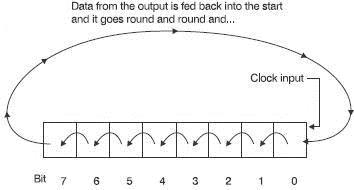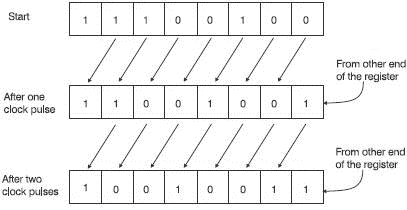Книга: Introduction to Microprocessors and Microcontrollers
Rotate registers
Rotate registers
These are modified versions of the shift registers. There are only two simple changes necessary. The first is that the data is loaded in parallel.
This means that the data is loaded into each flip-flop in the register at the same time. This requires a separate connection to carry each bit but the good news is all the data is loaded under the control of a single clock pulse so it is very much faster. Once loaded, subsequent clock pulses cause the data to be moved along the register as before. The last bit of data is connected back to the other end of the register instead of dropping off the end into our bin. Have a look at Figures 6.11 and 6.12.

Figure 6.11 A rotate-left register

Figure 6.12 Data movement in a rotate-left register
As with shift registers, rotate registers can be made in rotate right as well as left versions. In microprocessors, the same register can be used to rotate or shift in either direction.
The benefit of using a rotate rather than a shift register is that the data is not destroyed. We have seen that a shift register is progressively emptied as bits fall into the bin at the end. With a rotate register, the data is not changed. If we rotate left say, six times, we only have to rotate right six times to recover all the original data.
- A flip-flop or bistable
- A register
- Shift registers
- Rotate registers
- Memories
- RAM
- Accessing memory
- Two types of RAM
- Memory organization
- Three types of ROM
- Pin layout of an EPROM
- Pin layout of a SRAM
- Pin layout of a DRAM
- Some more memories that don’t fit into the general pattern
- Memory maps
- Quiz time 6




